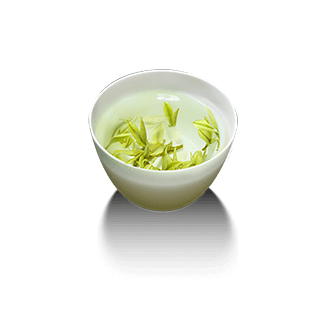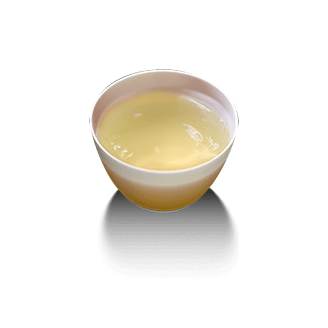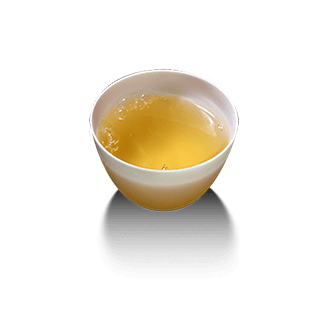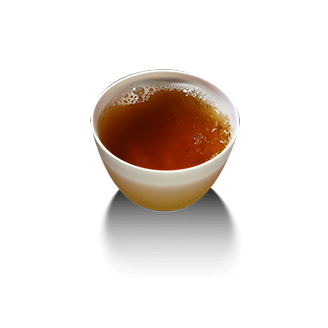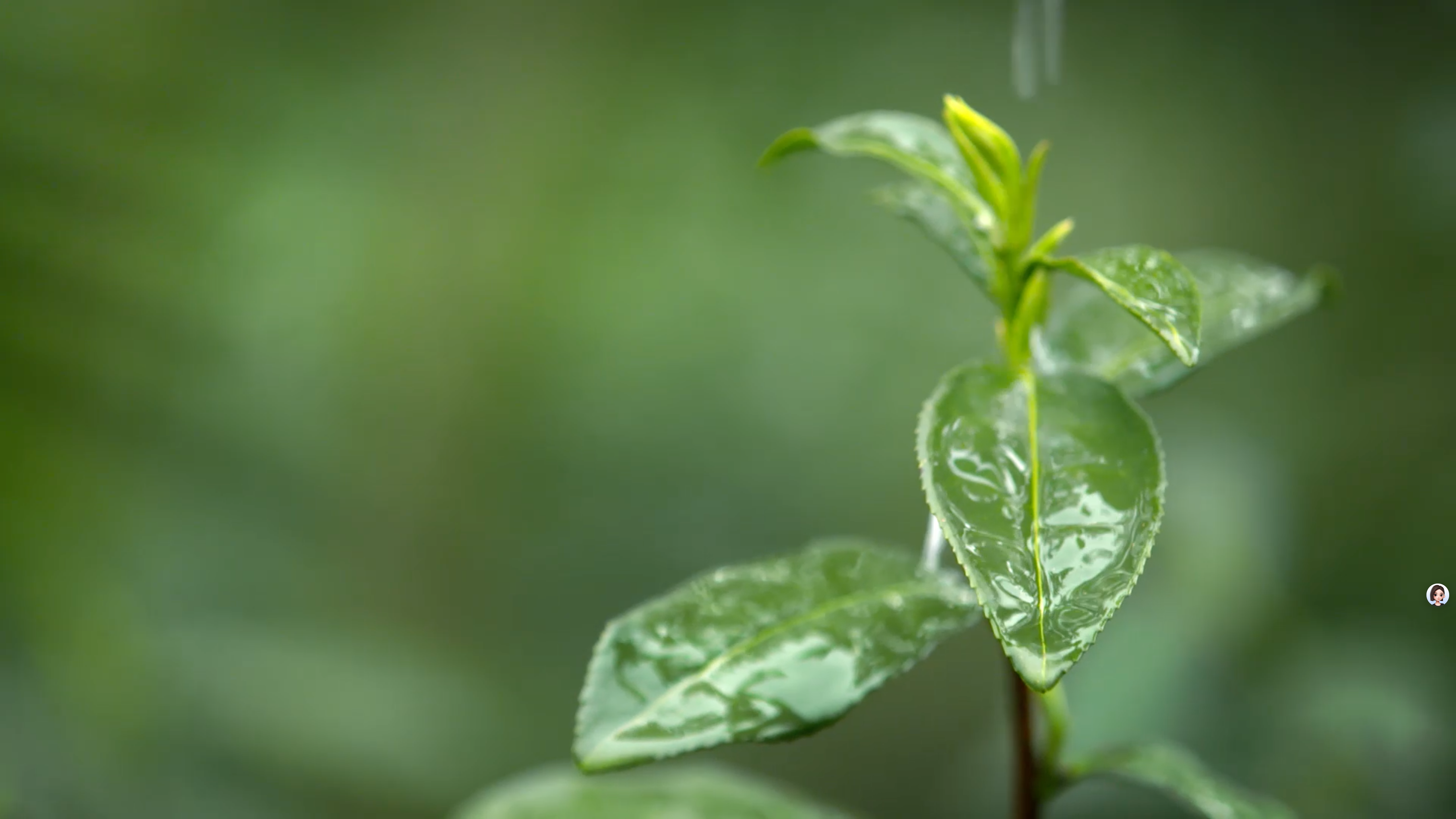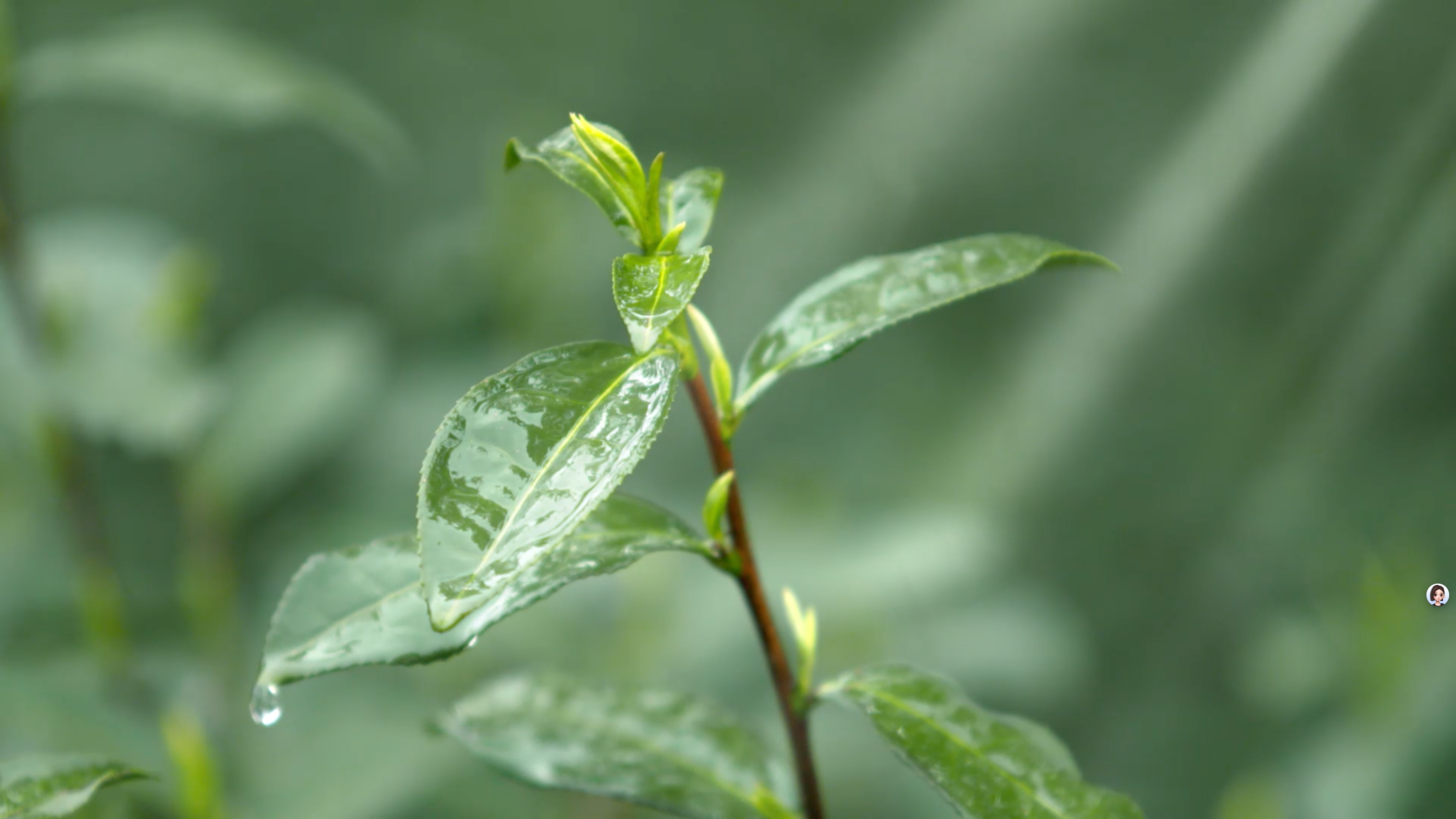
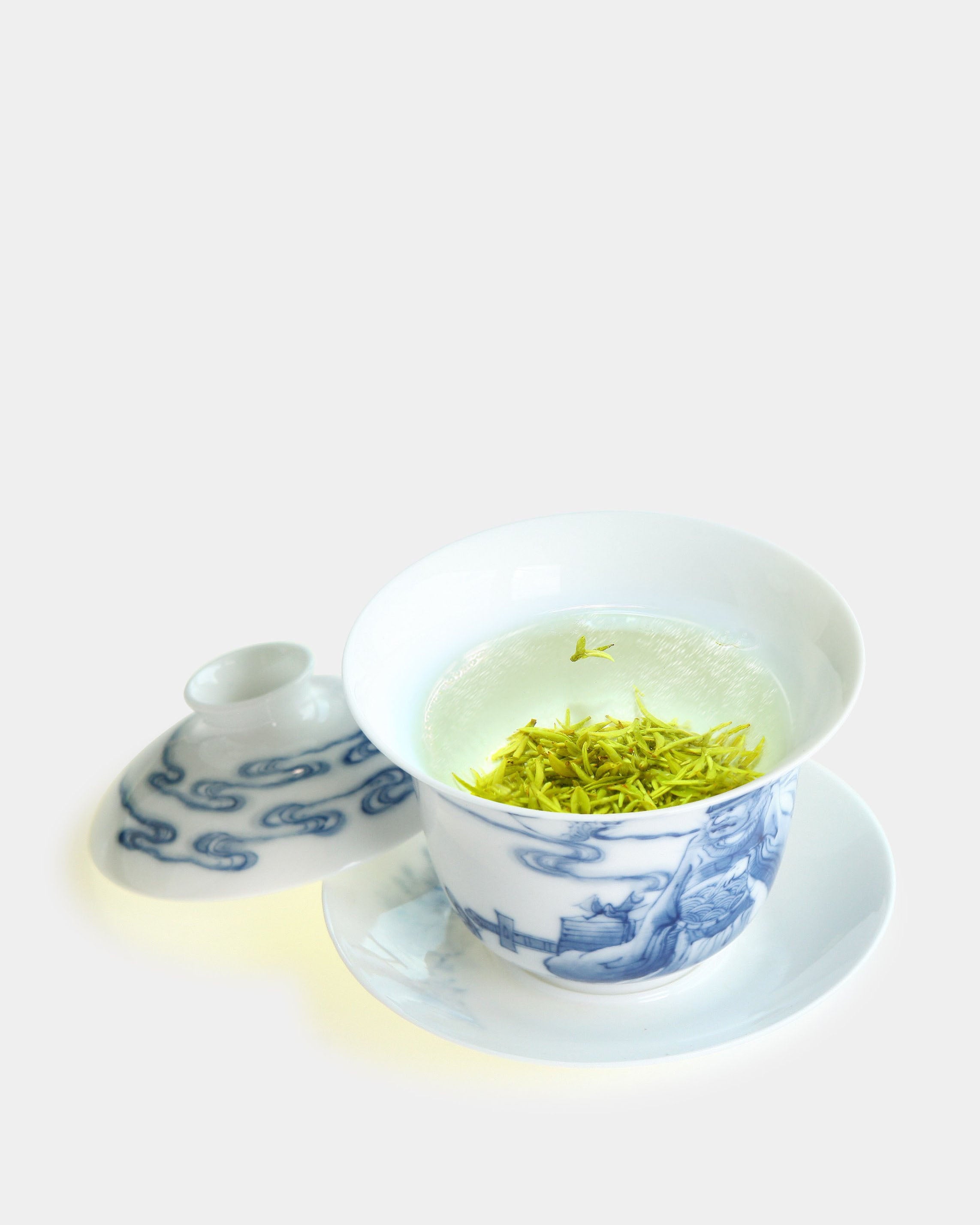


Dongting Biluochun





Dongting Biluochun
Since then the 'Little Niangyu' suffered
One pound of 108,000 buds

Since then the 'Little Niangyu' suffered
One pound of 108,000 buds
Dongting Biluochun Tea
洞庭碧螺春
In Biluo Village outside Suzhou, Grass grows, flowers bloom, tea leaves aroma.
Dongting Mountain—the origin of Dongting Biluochun tea—is embraced by mountains and waters, full of exceptional spiritual and vitality,nurturing the one-of-a-kind fragrance of Biluochun.
Yan Jielong, an ICH inheritor living in Dongting East Mountain, Taihu Lake area, is enthusiastic and hardworking. It takes him three and a half hours to fry and roll one jin of tea, leaving him with sore waist and back. That’s why the daily output of handcrafted tea is extremely limited.
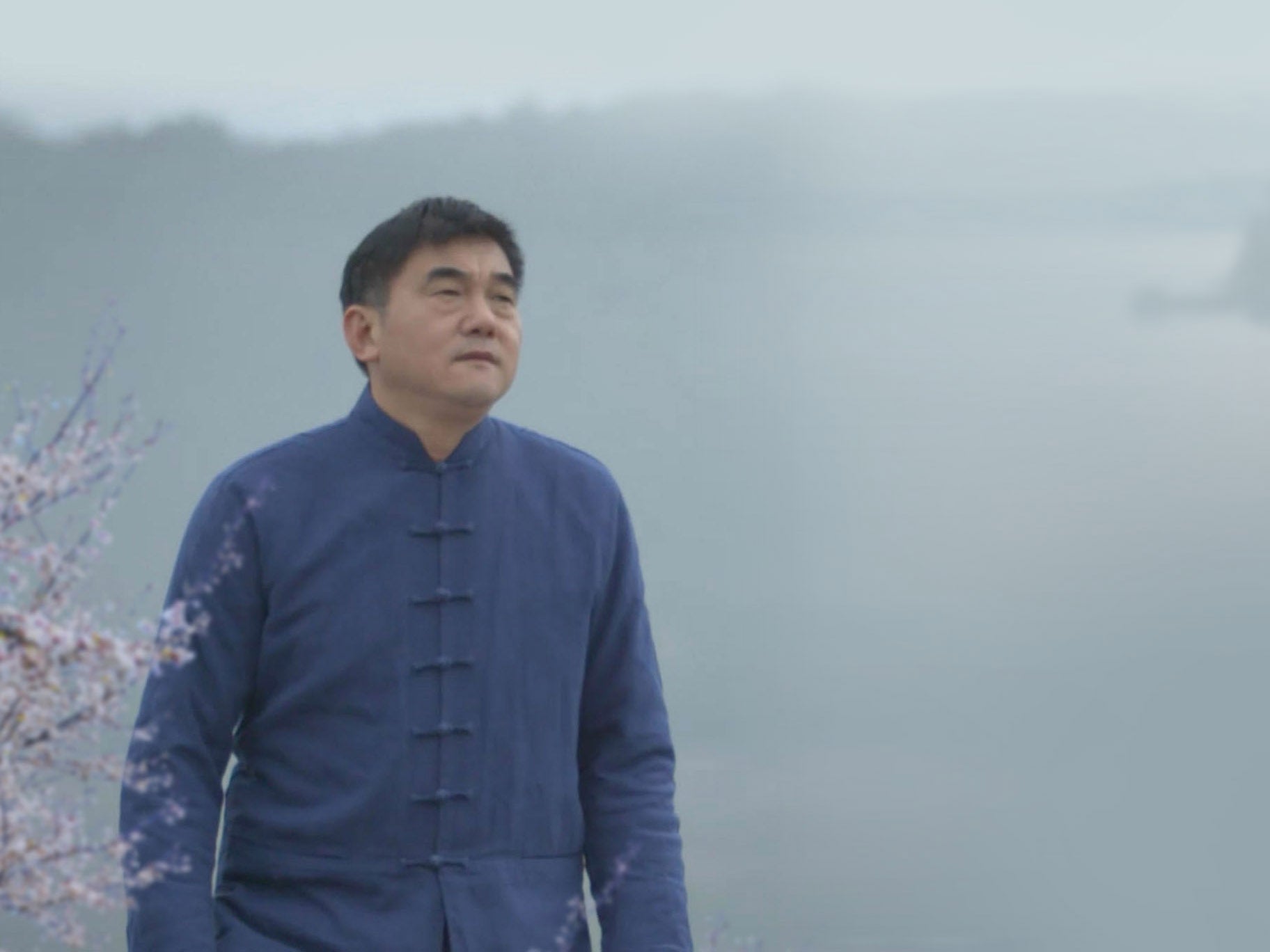
Picking tea is equally laborious.Biluochun tea leaves are extremely tender, as the poem goes:"Since then the 'Little Niangyu' suffer—one pound of 108,000 buds.""Little Niangyu" is a nickname for young girls in the Gusu area, meaning they have to pick 108,000 fresh tender buds to produce one jin of Biluochun tea.
The Biluochun tea brewed for us by Yan Jielong emits an enchanting fragrance, with a subtle greenish astringency and a long-lasting sweet aftertaste. A gentle sip leaves a lingering aftertaste, carrying the mind to a realm of lightness and transcendence. These tea leaves are picked from the finest buds of Dongting East Mountain before Ming Dynasty, and if compared to a beauty, they are just in their prime of maidenhood like cardamom.
The tea he brews for me and sells to me is always the most intact and finest; yet I’ve noticed that what he drinks himself is broken tea. In that instant, I understood the sweat and livelihood behind tea-making.
Yan Jielong possesses profound attainments and unique insights into the production of Biluochun tea. Life is long, and some people are worth befriending for a lifetime.
The tea farmers in the Dongting Mountains by Taihu Lake have made a living by growing and processing tea for generations.
A young man enthusiastically invited us into his family’s tea garden. There, tea trees and fruit trees grew alternately—tea leaves naturally absorbed the fruit aroma as they thrived, blending into a unique floral and fruity flavor. “The environment of my tea garden is truly blessed,” he said. “We cherish it deeply. The Biluochun I make with all my heart is no worse than anyone else’s.” His words carried a simple yet unshakable confidence. “Making tea relies on experience and intuition,” he added softly.
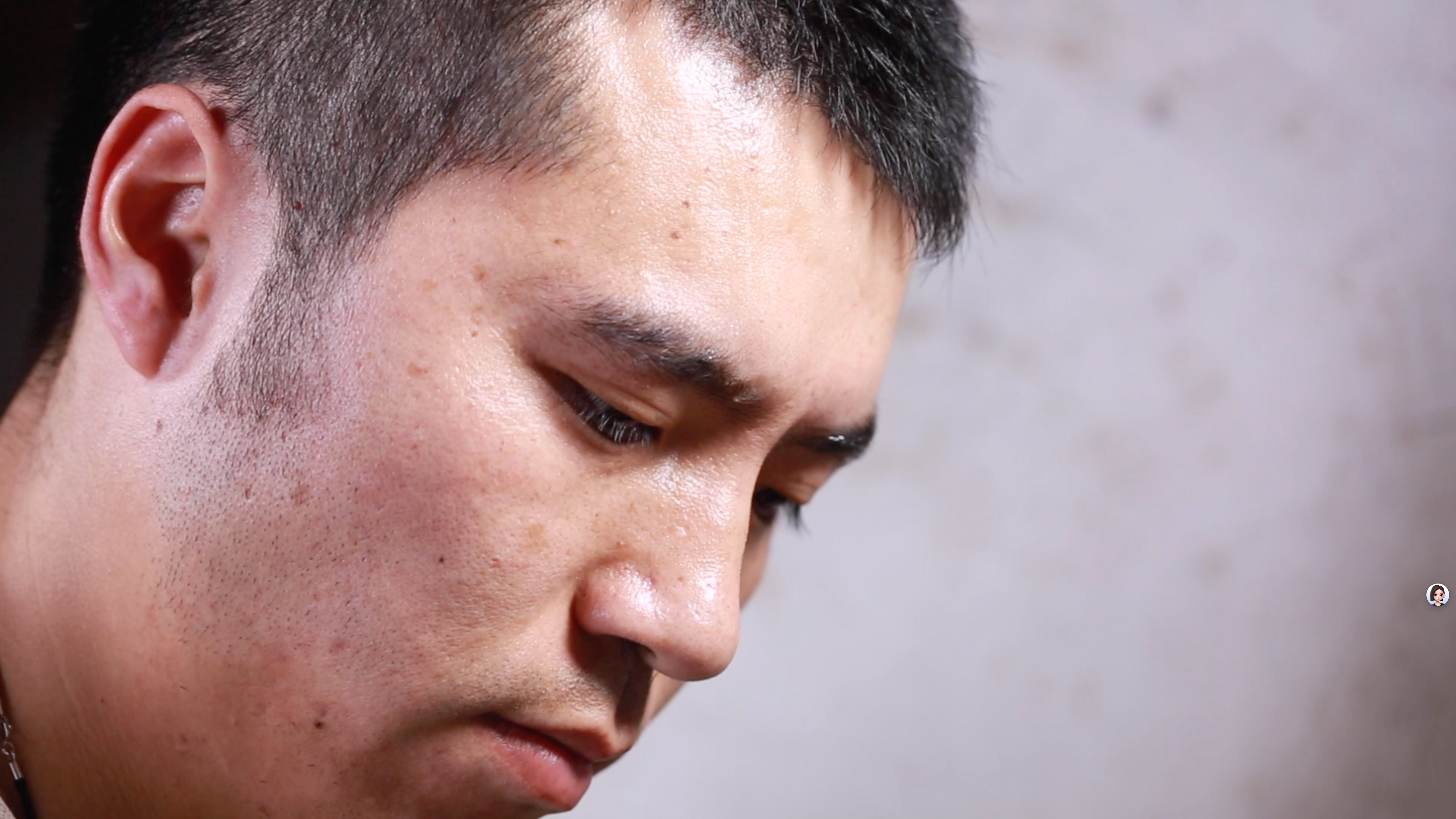
Every tea season, the whole family often works until late at night. Although it's hard work, they rely on this time for most of their livelihood for the year. It's tiring, but it's worth it.
He brewed us a cup of his homemade Biluochun tea, its aroma fresh and natural, its taste mellow and sweet. During our conversation, we also learned that he not only makes green tea but also Biluochun black tea.
Tea farmers diligently cultivate fragrant tea, and their ordinary lives are filled with profound charm.
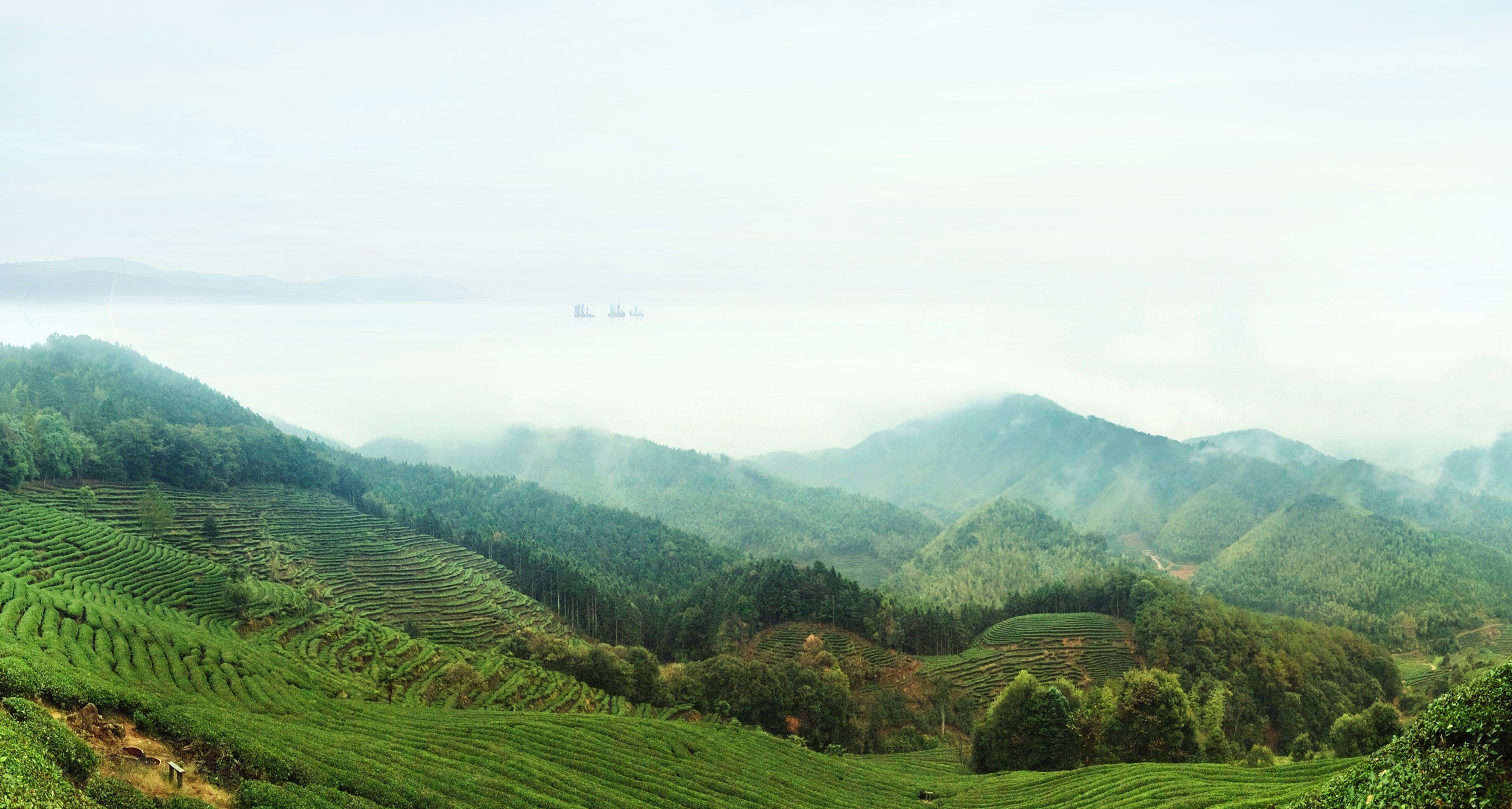
In Taihu Lake Dongting West Mountain, we visited Zhou Yongming, an ICH inheritor. He told us about the past of Biluochun tea: "Dongting Biluochun was originally called 'Xia Sha Ren Xiang' (meaning 'Startling Fragrance'). When Emperor Kangxi made three southern inspection tours to Taihu Lake, the local governor presented him with a cup of fragrant tea from the lakeside. After tasting it, Kangxi was greatly admired it, specially conferring the name 'Biluochun'. From then on, Biluochun reputation spread far and became the famous tea in Jiangnan, and was presented as tribute every year."
He also talked about the art of tea making, saying that the skill of tea frying usually requires more than ten years of immersion to reach a certain level.
Appreciation
Year: 2025
Grade: Top Rare, selecting only single buds.
Producer: Yan Jielong, ICH inheritor of Xishan, Taihu Lake
Origin: Authentic Biluochun tea country of origin Suzhou Taihu West Mountain. The roots of tea trees intertwine with those of loquat, bayberry, citrus, and other fruit trees, and the soil is rich in humus. Combined with the humid air of Taihu Lake and the temperature difference between day and night, this creates a natural endowment where "tea absorbs the fragrance of fruit and flowers infuse the tea with flavor."
Variety: Wild population
Process:
Harvesting: Picked before Qingming Festival. Only single buds are used, and it takes 60,000 to 80,000 buds to make one pound of tea.
Traditional stir-frying: The traditional hand-stirred stir-frying process involves seven steps, including blanching, kneading, shaping into balls to reveal the fine hairs, and drying over a low flame.
Secondary drying : The process involves two drying cycles. The initial drying temperature is 100-120℃, and the secondary drying temperature is reduced to 80-90℃, which strictly controls the moisture content to below 7%, locking in the aroma and extending the shelf life.
Appearance : The dry tea leaves are as thin as copper wire, curled into spirals, silvery-green with a hint of emerald, and covered with more than 95% white down. The top grade tea has one bud and one leaf just beginning to unfold, with the bud longer than the leaf.
Scent : The aroma has distinct layers:
Color Observation:
Taste : At the moment it touches the palate, the fresh and crisp sensation is like "mountain spring cleansing the tongue". The subtle astringency of tea polyphenols balances perfectly with the sweet freshness of theanine, followed by a lingering sweetness welling up from the base of the tongue, lasting long and gently.
Tea Liquor color: Bright tender green with a slight "Fuzz Suspension"
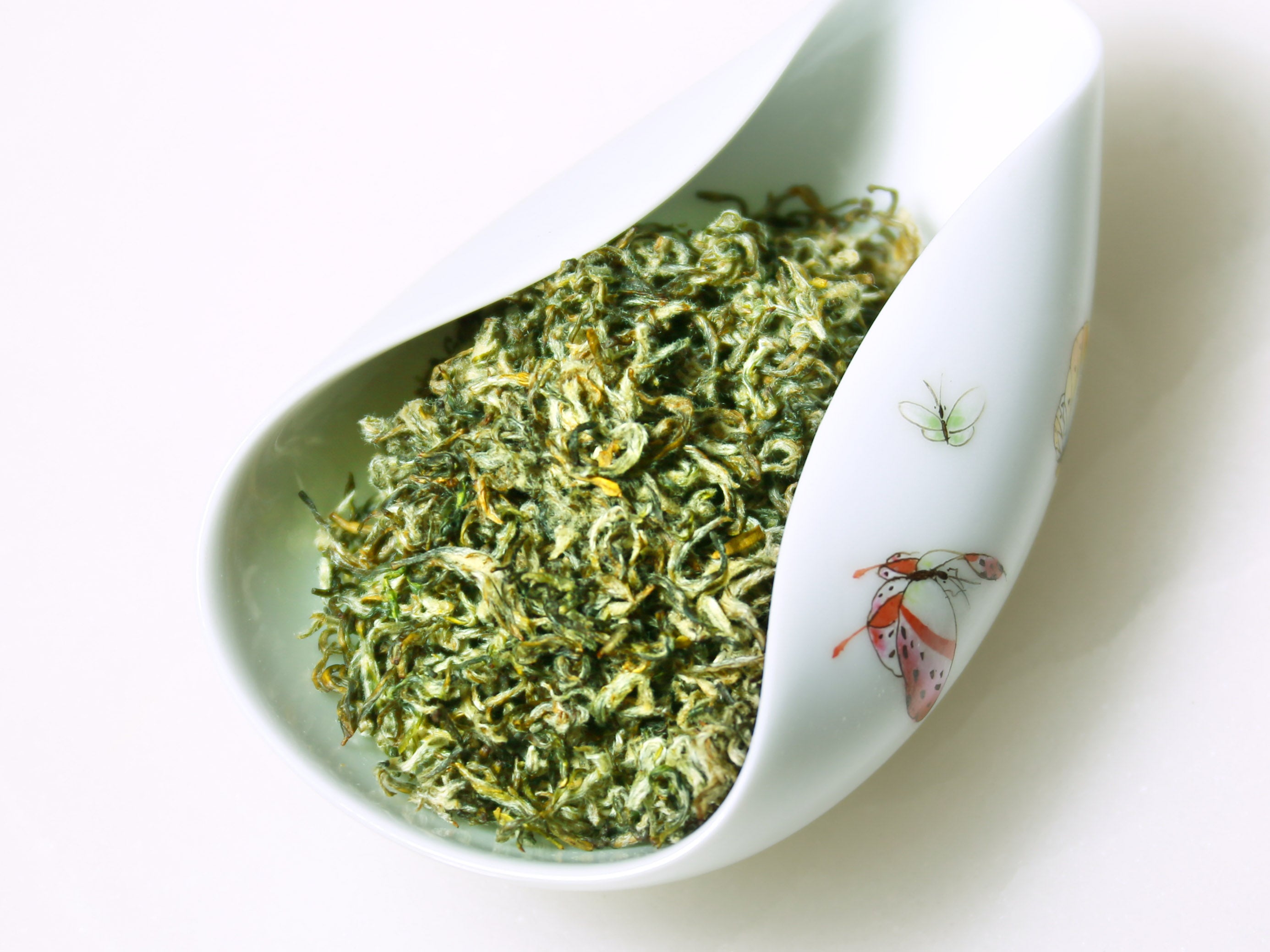
Dry leaves Appearance: Snail-like curls, silvery green hidden emerald
"Startling Fragrance" original compliment ;
Still have to picked early during the Spring Equinox.
- “Startling Fragrance” (Xiàshàrén Xiāng):The old folk name of Biluochun tea, literally meaning “a fragrance so strong it startles people” — a vivid folk praise for its intense, fruity-floral aroma, later renamed “Biluochun” (Green Snail Spring) by Emperor Kangxi of the Qing Dynasty.
- “Spring Equinox”:A traditional Chinese solar term (usually around March 20–21), marking the end of the optimal harvest period for Biluochun — early plucking (before/around this term) ensures the tea’s tenderness and delicate flavor.

"Startling Fragrance" original compliment ;
Still have to picked early during the Spring Equinox.
- “Startling Fragrance” (Xiàshàrén Xiāng):The old folk name of Biluochun tea, literally meaning “a fragrance so strong it startles people” — a vivid folk praise for its intense, fruity-floral aroma, later renamed “Biluochun” (Green Snail Spring) by Emperor Kangxi of the Qing Dynasty.
- “Spring Equinox”:A traditional Chinese solar term (usually around March 20–21), marking the end of the optimal harvest period for Biluochun — early plucking (before/around this term) ensures the tea’s tenderness and delicate flavor.
吓煞人香原夸语
还须早摘趁春分
Three Realms of Brewing in a Glass
Color Observation
The recommended tea amount is 3g to 5g,strength based on preference.
Pour 70℃ warm water gently,
watch buds and leaves unfurl and float in the glass,
tea liquor color fades from light green to clear,wet leaves stay fresh and vivid like new spring shoots.
Aroma Appreciation
Sniff the glass rim while it’s warm – the fresh, tender down fragrance lingers in the air, deeply refreshing your senses.
Taste Appreciation
The moment it enters your mouth, the fresh and brisk sensation is like "mountain spring washing your tongue".
The slight astringency of tea polyphenols balances with the sweet freshness of theanine.
Then a sweet aftertaste emerges from the bottom of the tongue, lingering long and steadily.
Brewing tips
1.Low-temperature brewing is key (70℃ is optimal)
Avoid Boiling water(100℃) for first brew causes 1st bitter, 2nd bland.
After the mouth is irritated, even if the subsequent water temperature is suitable, it will be difficult to perceive the tea flavor levels, and the true beauty will be missed.
Biluochun tea is often jokingly called " little rascal (Xiao Hun Dan) " by tea drinkers—this nickname holds subtle ingenuity :
"Little"(Xiao): The buds are extremely tender, " One pound of 108,000 buds";
“Misty”(Hun): High-grade Biluochun tea is covered with white fuzz, causing the tea soup to be slightly cloudy, which is exactly the mark of its identity as “snow buds and golden powder”.
"bland"(Dan): This is often due to excessively high water temperature (>80℃), which causes a rapid and large amount of caffeine, tea polyphenols and other substances to be extracted from the tea buds. This results in a sudden increase in concentration and bitterness in the first brew. Subsequent brews show a rapid decline in the content of these substances, creating an imbalance of "bitter in the first brew and weak in the second brew", rather than the tea itself being weak in flavor.
(Note: Correct brewing method: Pour in warm water at 70-75℃, observe the white downy hairs floating like spring snow falling into the cup, taste the fresh, sweet and mellow flavor like the fragrance of flowers enveloping the tongue, only then can it live up to the reputation of "frighteningly fragrant".)
Low-temperature Brewing Applicable Scope:All high-grade teas made from fresh, tender buds (e.g., Mengding Nectar, Biluochun, and high-grade black tea). The more delicate the buds, the lower the water temperature; slightly higher temperatures can be used for teas with coarser leaves.
2.Water quality is the easiest factor to overlook
Choose Qualified purified water; never use alkaline water.
(For commercially available mineral water brands, their water sources and quality indicators vary. So-called "high-quality mineral water and mountain spring water" may cause loss of functional components and inhibition of aroma in tea.)
Effect of Alkaline Water on Green Tea
Tea Liquor color:
When pH>8.0, chlorophyll and flavonoids are easy to oxidize, and the bright green color turns to dark yellow and turbid.
Taste:
It inhibits the dissolution of tea polyphenols and caffeine, impairs the fresh and brisk taste of amino acids. Additionally, calcium and magnesium ions cause the tea liquor to become turbid, significantly reducing its "richness and smoothness" and resulting in a rough mouthfeel.
Aroma:
Accelerate the degradation of volatile substances in clear-scented teas (such as jasmine tea), floral aroma dispersal, easy to generate water boring flavor.
Especially the fragrant tea (such as jasmine tea, Anji White Tea) floral aroma is easy to disperse.
When the fifteen-year-old moth-eyebrows maid are picked the tea ;
soft bosom cradle the green jade-like tea buds.
- The line depicts the traditional harvest scene of Biluochun tea: Young maidens (around 15, considered the most dexterous) pluck the tender tea buds. “Cradle green jade with soft bosoms” describes their gentle gesture—using their chests to lightly hold the buds, preventing damage and keeping them fresh. Here, “green jade” is a metaphor for Biluochun’s bright green, delicate buds, symbolizing their preciousness.
- The phrase “soft bosoms” (from “酥胸”) is not meant to be vulgar; it emphasizes the maidens’ tenderness and the care taken with the tea—a classic Chinese poetic way to blend human grace with the beauty of nature (tea buds).
蛾眉十五采摘时
一抹酥胸蒸绿玉
When the fifteen-year-old moth-eyebrows maid are picked the tea ;
soft bosom cradle the green jade-like tea buds
- The line depicts the traditional harvest scene of Biluochun tea: Young maidens (around 15, considered the most dexterous) pluck the tender tea buds. “Cradle green jade with soft bosoms” describes their gentle gesture—using their chests to lightly hold the buds, preventing damage and keeping them fresh. Here, “green jade” is a metaphor for Biluochun’s bright green, delicate buds, symbolizing their preciousness.
- The phrase “soft bosoms” (from “酥胸”) is not meant to be vulgar; it emphasizes the maidens’ tenderness and the care taken with the tea—a classic Chinese poetic way to blend human grace with the beauty of nature (tea buds).
蛾眉十五采摘时
一抹酥胸蒸绿玉
Package
"Forged Through Thousands of Hammers" Handcrafted Pure Tin Can
Height: 15 cm | Diameter: 11 cm | Net Weight: 250 g
Crafted by Sheng Yiyuan, ICH Inheritor of Yongkang Tin Carving.
The can body is shaped through thousands of manual hammer strikes, boasting a delicate and warm texture. Each hammer mark—varying in depth—stands as a unique imprint, a vivid testament to the warmth of handcraftsmanship and the profound meaning of intangible cultural heritage ingenuity.
The interior is finely polished using precision numerical control (NC) technology, ensuring a smooth and burr-free surface. The lid and mouth, crafted with high-precision techniques, achieve an airtight seal. This fusion of handcrafted warmth and modern technical precision preserves ancient charm while guaranteeing practicality.

Height: 15 cm | Diameter: 11 cm | Net Weight: 250 g

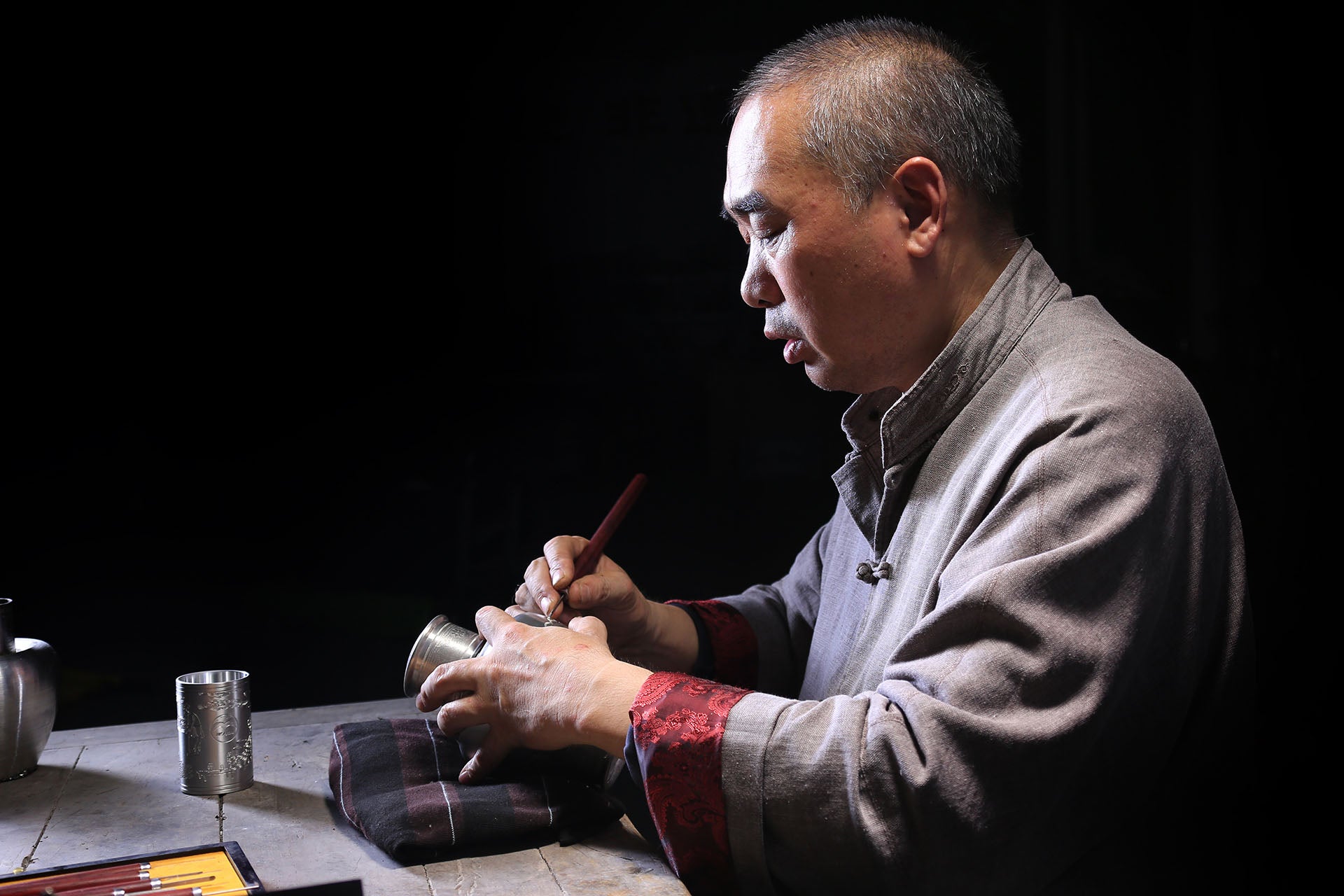
Sheng Yiyuan,ICH Inheritor of Yongkang Tin Carving
Green tea Storage

Freeze in airtight tea canisters at ≤-5℃
Do not mix with fresh food, keep away from light and moisture.
Note: Avoid opening the container frequently.
Each time you open the container, the tea comes into contact with air and moisture, accelerating the tea’s oxidation and spoilage.
Therefore, minimize the number of times you open the storage container.
Best before date: one year
Long-term Storage
Preparation: Clean the storage container
The container must be dry, odorless, and well-sealed . Pure tin cans, glass jars, metal cans, or food-grade aluminum foil bags are acceptable options.
New containers should be washed with hot water and thoroughly dried to avoid residual moisture or odors contaminating the tea.
Seal the mouth of the can or bag after filling the tea to minimize air entry.
Sealed Storage
Double-sealed packaging (such as aluminum foil bag + food-grade plastic bag) ensures absolute moisture protection and be sure to avoid light.
Store the sealed tea canister in the freezer (temperature ≤ -5℃), Store separately, do not mix with fresh food, and protect from odors.
When taking it out, the tea leaves should be moved from the freezer to the refrigerator to thaw before being placed at room temperature to avoid direct exposure to the air and the formation of condensation.
Small capacity short-term Storage
Store in a small metal or ceramic jar at room temperature, usually in the refrigerator, and drink within 1 month.
For gifting or collecting : High-grade green tea can be stored in a tin can + sealed bag + refrigeration to extend its shelf life.






